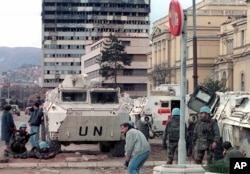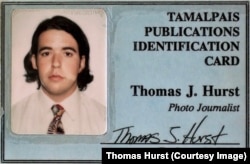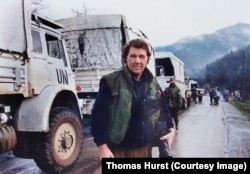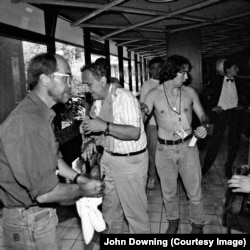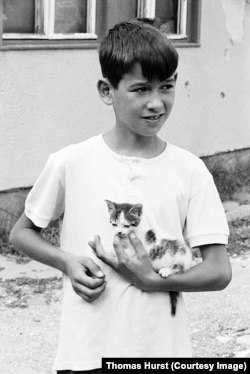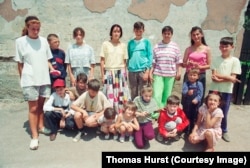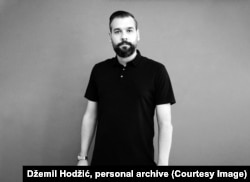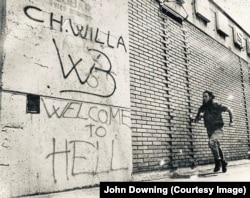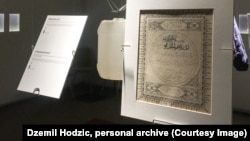A 30-year-old negative dug out of a Washington attic has fulfilled a Sarajevo siege survivor's dream and reminded the photographer that you never know how important those pictures are.
Bosnian Dzemil Hodzic's search through the backwaters of the Internet for wartime memories of his late brother began with a project he started called Sniper Alley in 2019. The website aims to "find, identify, and archive" photos taken in Sarajevo during the war between the years 1992-96.
A year later, a coincidental post by an American who, at 21, had faked his journalism credentials to chronicle the Bosnian War led to uncovering the only surviving wartime image of Amel Hodzic.
No Memories
"I've been looking through pictures for years -- looking for myself or anyone from the war. I was trying to find myself. I'd often log onto Facebook through my wife's account, and she once asked me what I was looking for. 'Just looking. I wonder if anyone ever took a picture of us. I don't have a single picture from the war.' It's as if someone took away a part of your life, a part of your memories," says Hodzic, who was 9 when the siege of Sarajevo began.
"I had a [Gabriel] Batistuta jersey from when he played [for Argentina] in the World Cup. I wish I had that picture of me playing football in that jersey."
At the urging of a friend, Hodzic wrote down his thoughts. They focused on the siege, which lasted 1,425 days. And he appealed, in English, to the photographers who had chronicled those years:
"I wonder if they are alive, covering other war zones, do they have more photos, do they have stories to share.
"At least six of them were there.
"Writing this wasn't easy. It took me more than 20 years. Lots of stops and starts. I hope this will help me and help all the other kids who lived through the war."
Student In Sarajevo
Californian Thomas Hurst first traveled to Sarajevo in 1992. He was 21 years old, with a fake journalist's card and a camera he didn't know how to use. He came, he later admitted, for selfish reasons: He wanted to know whether he was cowardly or courageous, and thought the best way to learn was in a war zone.
"The plan that I had formulated in my mind was that I would somehow get to Serbia, to Belgrade, and I would find the highway leading out of the city to Bosnia, Sarajevo," Hurst says. "I envisioned in my mind army trucks and tanks driving there and I would thumb a ride and, of course, they would stop, because why wouldn't they stop for me?"
When Plan A failed, and Hurst realized that he needed to go to Zagreb because planes carrying humanitarian aid for Sarajevo were arriving there, he hitched a ride aboard a German military plane to the besieged city. Within hours, he ran into renowned British photojournalist John Downing at the Holiday Inn.
"At that point," Hurst says, "I had been telling this ruse about me being a journalist with the newspaper that I had made up with my press credentials. But at that point I realized the seriousness of the situation, and I realized that John was clearly a journalist and a photojournalist."
Hurst realized that he couldn't lie to Downing and confessed everything to him. Downing had won numerous international awards and had just received the Order of the British Empire for his "service to journalism."
"I just came clean to John: I'm a college kid trying to figure this out. And John was impressed, but he was also worried, which is why he took me under his wing."
Hurst said he simply followed Downing and shot what he shot. His first photo was of two dead children. Two-year-old Vedrana Glavas and 14-month-old Roki Sulejmanovic were on a bus that was to evacuate children from Sarajevo's largest orphanage. Snipers from a Bosnian Serb Army position fired on the bus, killing Glavas and Sulejmanovic.
"In that moment, I had just sort of an awe-inspiring beam of light and was, 'OK, this is what I'm going to do with the rest of my life,'" Hurst recalls.
Hurst went back to the United States to complete photography courses before returning to Sarajevo in the summer of 1993. The Holiday Inn was expensive, so he stayed instead in the home of a woman who had translated for Downing a year earlier. Still, he said, he was no photographer:
"Kids were easy [to photograph]. I just walked around all over Sarajevo taking pictures. But if you looked at most of my images, they were mostly kids all around Sarajevo."
'A Series Of Incredible Coincidences'
In 2020, Downing died. By chance, Hodzic saw a colleague's tribute to the British photojournalist and clicked on it. He noticed a photo of Downing taken by Hurst: "And I thought: 'Look, he was in Sarajevo, too.'"
Hodzic messaged Hurst on Facebook. It took the American months to respond. Hurst's first question was: "How do you know about me?" Hurst realized that Hodzic was looking for a memento of his brother and asked him where the Hodzices had lived during the war.
"I gave him the name of the street -- Frontovska, above Bascarsija in the Old Town, below Spicaste Stijene -- and gave him the exact coordinates," Hodzic says. "He said, 'I lived on what's now Safvet-beg Basagic, with this and that family. I passed through your streets many times.'"
If anyone in the world had a picture of Amel, Hurst thought, it's me: "I didn't tell [Hodzic] this, but I just knew I had the picture."
"I would never take these same pictures that I took in '93. Kids just staring at the camera. It's not a picture. It's never gonna be published," Hurst says. But, after the Bosnian found him, Hurst took the negatives out of his attic in the U.S. state of Washington, bought a scanner, and started sending pictures to Hodzic.
"On March 25, [2021], I received an e-mail while I was in the car. There was one, another, a third picture...and a picture of me holding my cat," Hodzic recalls.
"I started crying. Those tears can't be described. Both sadness and joy mixed together."
Half an hour later, in another e-mail, Hurst sent a group photo that included Dzemil and Amel.
"I couldn't control myself anymore, in terms of emotions, sadness, and joy.... You just want to go back to that moment, to remember as much as possible, to take it all in," Hodzic says. "I remember the streets and the houses. All the friends from the picture are alive, except my brother."
When Hodzic confirmed to Hurst that he'd found his brother, he was overcome with emotion.
"I just wept. What a powerful series of events that spanned almost 30 years, and all these things had to be set in the right way," Hurst says. "I had to be an inexperienced photographer to do that. Because an experienced photographer doesn't have those pictures. And I had to have stayed in that neighborhood. And I had to have the negatives."
Amel Hodzic was killed on May 3, 1995, by sniper fire from a Bosnian Serb position at Spicasta Stijena, a rocky cliff overlooking the city. It's just a few meters away from where the picture was taken. In all, 1,601 children were killed in Sarajevo during the war.
"After Amel was killed, my mother didn't want us living on the same street any longer," Hodzic says. "Within two weeks, we had left and moved to [the neighborhood of] Bjelave. It just reminded her of him every day, because Amel had died on her lap, almost in front of the house."
Life After The War
After studying in Sarajevo, Hodzic moved to Qatar in 2007, where he works as a video editor on Al Jazeera documentaries. He's now 39 years old and has a son named after his slain brother. "So no matter what, we won," he says.
Hodzic says all of the other children in Hurst's photo survived and have good lives. "You didn't kill us, even though you wanted to," he says. "They took our youth and many other things, but we're going to look to make up for it and give it back in some other way."
Hodzic says he still hangs out with Elvis, one of the boys in Hurst's picture, whenever he comes to Sarajevo.
In some pictures from besieged Sarajevo, it seemed like life would never return to the city. "In those moments, it was hard to envision what it would look like when there was not war," says Hurst. But now that he's in contact with Hodzic, he says, he feels grateful.
"It means that there's hope and a chance for healing.... I'm grateful that many of these people got a chance to grow up. I would like to think that there is a generation of children from Sarajevo that have taken that experience and that it has made them kinder and maybe gentler and maybe more patient," Hurst says.
After Bosnia, Hurst was in Kosovo in 1999, freelancing for Time magazine, The New York Times, and other Western media. He later worked in Rwanda, Afghanistan, and Iraq.
"I left war photography in 2009. Because after almost 20 years, I had believed that if people knew what was happening, if they could see it, they would demand change. But change doesn't come from head knowledge. It comes from the heart changing. And information in itself doesn't change that," Hurst says.
But his experience with Hodzic rekindled Hurst's interest in war photography. He was inspired to travel to Burma (also known as Myanmar), only to return a short time ago.
"You don't always get to know who you're going to impact. You don't always get to know how important are the images that you make. Or if you do, it might be 30 years down the road," Hurt says.
'A Project Bigger Than Me'
As much as Sniper Alley tells the story of his childhood and life in a besieged city, Hodzic says it is also the story of the photographers who documented those days. His website lists 286 photographers of wartime Sarajevo and contains 92 galleries.
"I see all this as a responsibility, but also a great victory. Every time someone below the picture writes that he is alive, that he is working, that he is in America, that he is doing anything, my first thought is that it is a victory," Hodzic says.
Amel Hodzic was 16 years old and in the second year of art school when he was gunned down.
"I have a feeling that I'm his legacy -- that some of his life that he couldn't fulfill, I feel like I continued," Hodzic says. "[Amel] was always the one in the family who was an artist, drawing with his left hand. I never dreamed I would be where I am. There is this regret. In a way, I saw him as much more valuable and of better quality. What I'm doing today, in a way, is his subconscious."
One of his brother's unfinished levhas, a calligraphic quote from the Koran, is displayed at Sarajevo's War Childhood Museum, which in its exhibition also depicts childhoods lived under sniper fire and shelling.
"When you look at those pictures of war, the first success is that we survived. I never say only Amel died from the picture -- even if to me he is everything," Hodzic says. "We can say we are fortunate that only one person from the picture died. It could have been a grenade and killed us all."
Meanwhile, Hodzic's Sniper Alley project has met its initial goals, and he now has reminders of his brother and of life under siege. But the project has also outgrown his story and become an archive of life in a city targeted by a brutal army for 44 months. A siege in which 11,541 people were killed.
No individual charges have ever been filed before The Hague war crimes tribunal or Bosnian judicial institutions against the snipers who killed Amel or his fellow Sarajevans.





